|
2020 Summer NACDEP Newsletter
NACDEP Colleagues,
Greetings and welcome to the summer 2020 NACDEP newsletter. This post-Conference edition is absolutely loaded with all kinds of information from our NACDEP colleagues. We have items about the 2020 Conference, an early look at next year's 2021 Conference, some insights into the post COVID-19 era, a survey you can take to inform the Member Services Committee about your opinions on their Webinar Series, and lots more. I am so grateful to the membership for helping to make our newsletter one of the very best assets our organization has to offer.
Remember, if you have questions, comments or suggestions concerning the newsletter, or if you are unsure about ideas you have for submissions, feel free to get in touch with me. The Communications Committee (Comm Comm) and I have been very flexible over the years in adapting or modifying publication procedures to keep up with changing times, and we will continue to be flexible and responsive to the needs of the membership in the future. And now, enjoy the summer newsletter.
Thomas W. Blaine, PhD
Newsletter Editor
President's Letter
Submitted by Adam Hodges, NACDEP President
Dear Friends,
Thank you for your support and participation in yet another great conference. While it was not what we may be accustomed to at NACDEP, it was definitely the kind of collaborative, innovative, collegial, and fun event we are known for. I am grateful to have heard from many of our new members that even in a virtual format, the family that is NACDEP shone through. As our home lives and our work lives move in and out of potential crisis, please reach out to your NACDEP family when you need help. I had a recent conversation with the president of one of our JCEP organizations who offered this great insight. She explained that she felt she had a support system she could call on anywhere in the country at a touch of her smartphone. She had, in fact, used it when she had a child stranded at an airport. She is right, our Extension colleagues are everywhere and we are a big family. I know if I need real help there is someone nearby I could turn to and hope you feel the same about me. In fact, helping each other is at the core of who we are and what we do. We have important work to do to help all our brothers and sisters in this country during these stressful times, don't forget you have a network to call on whenever you need it.
Adam
2020 Annual Conference (and more) Available on YouTube.
Submitted by Jan Steen, NACDEP Com Com Co-Chair

While we didn't get to see each other in person in Portsmouth, NH, this year, we did encounter some positives in our move to hold the conference virtually.
- Several attendees mentioned they wouldn't have been able to participate this year in person due to the cost or time commitment.
- Many of us wore shorts or sweatpants throughout the conference (and some still are).
- We ended up with a lot of great recorded content we can revisit and learn from for years to come.
While there are certainly benefits to meeting in person, this year's conference gave us so much more recorded content than we've had in the past. Everything we were able to capture is on our YouTube channel, from the New Member Orientation session to the awards presentation, COVID-19 capnote, and post-conference Q&A with our keynote speaker, Julian Agyeman. We probably even have that concurrent session you missed because you had such a hard time choosing between two or three others. Be sure to check it all out on the channel: https://www.youtube.com/channel/UC6jgLtvNTItp0ucgmrw4XPA. While you're there don't forget to re-watch the virtual tours created by our talented UNH videography team.
The YouTube channel has been organized into different categories now for easy navigation. You'll see the NACDEP 2020 Conference section, of course, Webinars for non-conference educational content, and Featured Cooperative Extension Content, a place where we collect your great work that exists online. Do you have something you think would be at home on the channel? Send a link to [email protected] for review.
Belonging
Submitted by
University of New Hampshire Cooperative Extension
Molly Donovan,Community Economic Development State Specialist
Casey Porter,Community & Economic Development Program Manager
Shannon Rogers,Nature-Based Economic Development State Specialist
Community development work is about making changes to improve conditions in community. Change comes in different forms: regulatory change for more housing or volunteer efforts to spruce up Main Street. Community development practice is based on democratic engagement, participation and inclusion. We work to give everyone a voice and a role in the improvement of their community. This work is rooted in place, which can be a small town, city, downtown or neighborhood.
It is an unprecedented time in community. We have seen vibrant main streets become empty due to pandemic restrictions. We have seen an increase in walking, local trail use, appreciation for our natural spaces and the use of public spaces to assist with business re-openings. We have seen displays of support and hope. We have seen protests and calls for racial justice. This is a time of learning as we examine where we are, how we got here and what we need to do differently to strengthen community.
Recently, Extension's Community and Economic Development Team hosted the National Association of Community Development Extension Professionals (NACDEP) annual conference. The feature was the plenary session by Dr. Julian Agyeman, Professor of Urban and Environmental Policy and Planning at Tufts University and the originator of the concept of "just sustainabilities," which is the intentional integration of social justice and environmental sustainability. Sustainability is not simply an environmental issue and it is necessary to focus on human equality and environmental quality together.
Dr. Agyeman posed the question: What does belonging look like if your culture, history, art, customs or food are not represented in community buildings, parks, streets, shops and activities? How we design community spaces impacts who uses them and feels they belong. He also encouraged us to think about 'local' as a cultural idea not a geographic idea. For example, what does local food mean? Is it food that is historically grown or "should" be grown in an area or food grown that people want to eat, like foods from different cultures? We are called on to consider these ideas, especially now, as we work toward economic recovery and rebuilding in communities. How are we using our streets and parks differently? Do people from different backgrounds feel they belong in our public spaces? Do we now have a better understanding of the important role small business play in our communities, and how we can better support existing and newly created businesses? If we endeavor for creative placemaking can it reflect new cultures and traditions? As we use our civic centers, can we consider programs that reflect the cultures and histories of those who recently call this place their new home, while recognizing the native cultures that were the original inhabitants? Who is not at the table to make decisions about our community spaces? As Dr. Agyeman stated, this present time is a teachable moment and provides an opportunity for a paradigm shift - to move past systemic injustice and towards equity and inclusion.
Extension is here to teach communities to assess, engage, debate, decide and act. In order to foster belonging we can engage community members intentionally, moving beyond demographic data, to learn about their stories, needs and desires. Moving forward, it is our responsibility to understand our own identities and the identities of the people in communities we work with. Identity shapes our experiences and can be a source of belonging, pride or discrimination. We will work more deliberately with community leaders and volunteers on this critical concept of belonging.
Pandemic, Disaster or Engine for Positive Change
Submitted by Steve Fischer
I started an article filled with what I felt were the reactions to the COVID-19 pandemic that the Winnebago Tribe has taken. After the standard boilerplate, I drew a blank. What were we doing any differently than many rural communities? What differentiated the Winnebago Tribe from other tribes' action plans to the pandemic crisis?
I hit the brakes and took a wider view. What the Winnebago Tribe has done is looked back at its own history and culture to answer many of the "problems" facing it. Food sovereignty has been a buzz phrase for several years in the wider Native American community, and the tribe has taken an active role in promoting self-sustaining agriculture.
Before there was any hint of a pandemic, the Winnebago Tribe had decided to pursue the creation of a large tribal garden, a regenerative egg production program, and raised bed gardens for community members. Little Priest Tribal College Extension has had the opportunity to assist in all of the endeavors, doing our best to help facilitate, promote and execute the plans put forth by the Winnebago Tribe.
Little Priest Tribal College Extension, through the USDA-NIFA and American Indian Higher Education Consortium grants, was able to provide seeds and seedlings to the tribal garden and community gardeners. We have had the privilege to assist with the planning, planting, and advising of the Tribal garden. Included in the planning is using trellising and tomato cages, as well as the care and watering of a small orchard near the garden site.
There have been processes, implemented by the Twelve Clans Unity Hospital and Winnebago Health Department, to safeguard the tribal members, visitors and essential employees. Food, and water was distributed through the Atlas Program, WIC, Winnebago Food Distribution, and Ho Chunk Incorporated among others. CARES Act funding has been budgeted and a long-term plan put in place to address future crisis management. The real plan has been to look back at the traditions of self-sustainability, sharing with others, and providing for the elderly, which have been the strength of the Winnebago Tribe in facing this most recent crisis
Survey of NACDEP Members on Webinar Series
Submitted by MIchael Dougherty
The NACDEP Member Services Committee is planning its webinar series for 2020-21. But, before we finalize the schedule, we want to find out what subjects are of interest - and are the priority - of the membership.
The committee has developed a brief survey for members to complete to indicate what subjects they would like to see covered over the next year. The survey can be found here: https://wvu.qualtrics.com/jfe/form/SV_1TBhwhyPfGIHZn7
The committee would like to have the surveys completed by July 31, 2020.
The webinar series will begin on August 12 at 3 p.m. EDT with a session on "Board Diversification" by Melinda Grismer of Purdue University, NACDEP's President-Elect. It is a follow-up session from the REAL Talk entitled "All A-Board" that she gave during the virtual conference. More information about the webinar and the Zoom link will be shared closer to that date via an email blast.
For more information, contact Michael Dougherty, the Member Services Committee Chair, at [email protected] or 304-293-2559.
LatinX Extension Professionals Opportunity
Submitted by Jocelyn Hernandez-Swanson
Hello everyone! I am Jocelyn Hernandez-Swanson, a Leadership & Civic Engagement Educator based out of Southwest Minnesota. I am putting out a call for Extension professionals who would like to be a part of a Latinx Extension Professionals group. This group would serve as a base for Latinx Extension professionals to discuss, advise, and collaborate on efforts to engage the Latinx communities we serve. I would love to plan a meeting soon. Please email me at [email protected] if you are interested!
Thanks!
NACDEP 2020 Award Winners
Submitted by Tamara Ogle
This year we will be featuring a few of our National Award winners in each of the newsletters. This is another opportunity to share some of the great work our NACDEP members do in community development. We want to congratulate all of the National and Regional Award winners for 2020!
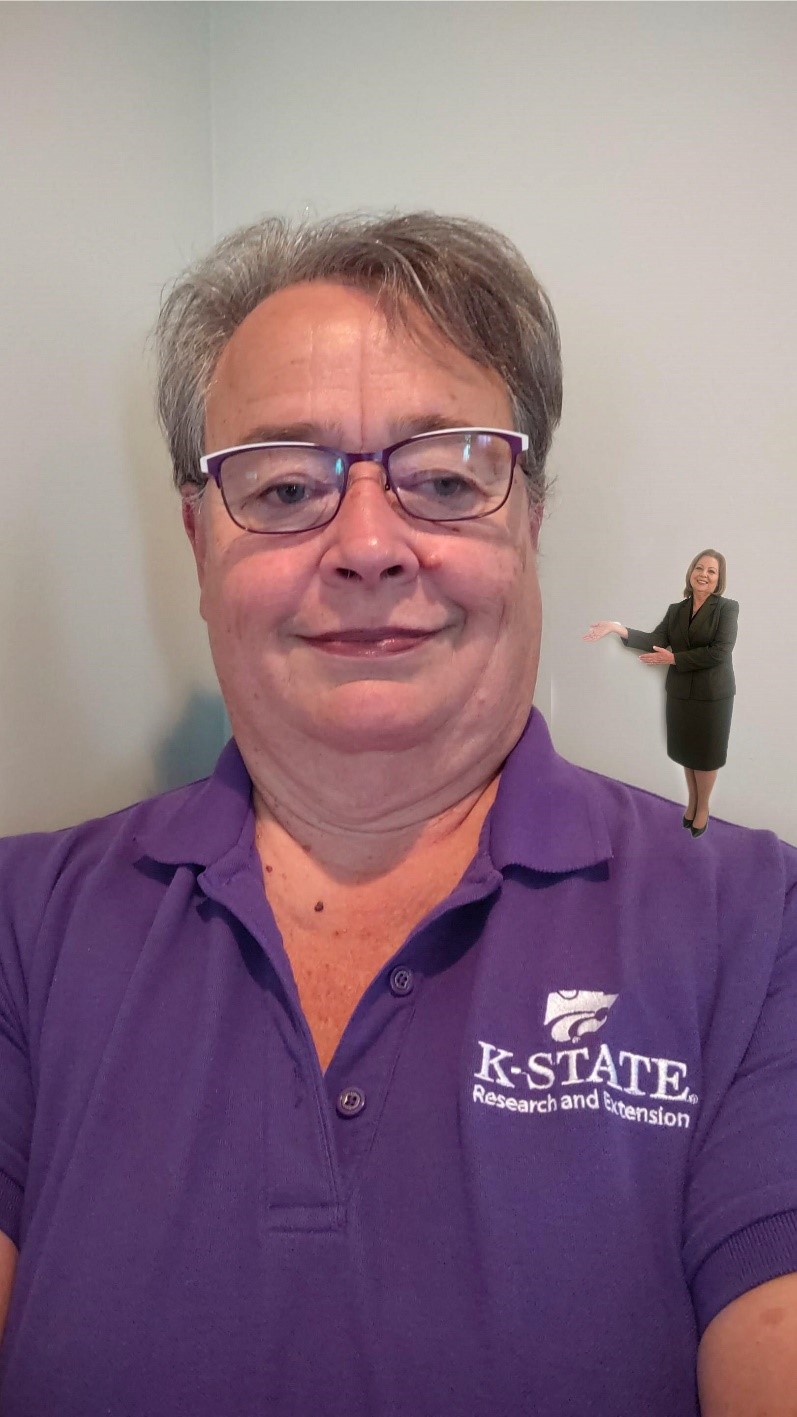
2020 NACDEP Distinguished Career Award Winner
Trudy Rice, Kansas State University
Trudy Rice is the K-State Research and Extension program leader coordinator for community vitality. Currently, the focus of her community vitality team is centered on community assessment, community organizing, community improvement, celebration and evaluation. This process is supported through the development and delivery of programs such as First Impressions, Master Community Facilitator, the Kansas PRIDE Program and many more.
The state specialist team has grown by 3.5 specialist FTEs during her leadership through the pursuit of public/private partnerships that have raised more than $2 million.
Along with this growth in Extension personnel dedicated to community vitality in Kansas, Rice was instrumental in organizing KACDEP and ensuring its formal affiliation with the National Association of Community Development Extension Professionals. Today, KACDEP serves as a catalyst for numerous efforts, both proactive and in response to emerging needs.
"Trudy lives and breathes the ideals of community development," said Gregg Hadley, director for Extension in Kansas. "She is a tirelessly positive advocate for bringing people together to analyze local issues and mobilize people to work together and achieve solutions. If you've ever seen her orchestrate a conference room full of people to walk through an issue step by step, with everyone involved and committed to future actions - all while the meeting sticks to the announced schedule - you've seen an artist at work."

2020 NACDEP Excellence in Teamwork Award Winner
Livestock Emergency Response Program, University of Nebraska
Kim Clark, Rob Eirich, Ashley Mueller, Megan Patent-Nygren, Chelsea Kramer
In a state where agriculture is the leading industry, and hundreds of thousands of animals are being transported every day, more than 2,500 crashes involving animals (NDOT) occur annually in Nebraska. Helping local first responders prepare for these events keeps our roadways open and safer for the traveling public. A multi-disciplinary team came together to bring the Bovine Emergency Response Program to Nebraska. Part of the approval from our administration was to expand the program to address all livestock species traveling in the state.
The members of this team work in offices separated by 403 miles in different disciplines and report to different supervisors. Coming together to develop working relationships, expand and re-write an extensive curriculum, seek external funding, and administer a new program that is a small part of any one team member's position has been a challenge. This team has been successful in each of these areas. This team has an informal organization. While some members gravitate to certain tasks, there are no assignments. Everything has been done without a designated chair. Meetings are in-person, via web conferencing, and via email. To date, the team has delivered five trainings with 152 participants with more waiting for a green light for in-person programming to resume.
Rural America Offers Positive Alternatives in The Aftermath of Covid-19
Submitted by Ron Wilson, director, Huck Boyd National Institute for Rural Development, Kansas State University and Paul Hill, professor of Extension, Utah State University Extension
Concentration contributes to coronavirus. Nationally, COVID-19 struck worst in certain "hot spots" or corridors with concentrations of travelers and other people, including those in urban areas. As one would expect, when people are crowded together, the likelihood of person-to-person transfer is greater. That is the point of social distancing. No place is immune - all states have had coronavirus deaths - and not all big cities have suffered as much, but New York, for example, was especially hard hit.
According to the Centers for Disease Control and Prevention, there were 1,062,446 cases in the U.S. as of May 1. Nearly thirty percent of those, or 299,106 cases, were found in a single state: New York. (This is far from New York's six percent proportionate share of the nation's population.) The grim death toll is even worse. At that time, of the nation's 62,406 deaths, 23,211 - or 37.2 percent - took place in New York, with many of those in New York City. More recently, the numbers of cases in other states are catching up.
As of June 26, 2020, those states with the highest COVID-19 incidence were New York, California, New Jersey, Illinois, and Texas. The continental states with the lowest COVID-19 incidence were the rural states of Maine, Montana, North Dakota, Vermont, and Wyoming. Many rural areas had low COVID-19 incidence, except for those communities with large meat-packing plants where workers were operating in close proximity. Was the high incidence of urban COVID-19 because, as is the case with many trends, the coasts got it "first and worst" before it came to the heartland? Is it because the grim experience in New York informed the states in the west about the importance of staying home and social distancing, providing advance notice to put in place those practices before the pandemic spread so drastically? Is it because uncongested rural areas, by their nature, allow for social distancing?
In general, evidence suggests that concentration of the population - especially when complicated by other societal factors - means a higher risk of coronavirus.
We grieve for the tragic death loss in New York and the disproportionate impact on urban and black Americans. We must also consider what this means for the rest of the nation and what lessons may be applied from the impact of coronavirus. We believe that rural America can offer a positive alternative for our citizens in the future. Here are three key points.
First, working remotely has been demonstrated to be a workable strategy for many people. COVID-19 and the resulting policy response were a huge shock to the American system. In a matter of weeks, people transitioned to working from home instead of at the office. Constant video conference calls and webinars became the order of the day. We learned, by necessity, that we do not have to be in physical proximity with our colleagues. Using the tools of technology, we can connect virtually with coworkers, bosses, employees, customers and stakeholders. While not always ideal, remote work is certainly a useful strategy for continuity of business operations given our current circumstances.
Whatever the state of the coronavirus disease, will we return entirely to the old way of doing business? We don't think so. The COVID crisis merely accelerated the societal trend in favor of remote work. Businesses know that the key to success is recruiting and retaining talent, and a degree of flexibility may be important in attracting such talent. Potential employees want the flexibility to have time for family and other pursuits and to live where they choose. Employers will need to allow remote work to attract such top performers, and they will find concomitant positive results. Remote work is a growing trend, and the coronavirus crisis has demonstrated these benefits to a world-wide audience, even though literature on the subject has been explaining the advantages since the 1970s. We believe this innovative practice has value for employees, employers, and rural communities where remote workers can live and flourish.
Utah State University Extension has been a leader in the development of helping people work remotely. In 2017, many of Utah's rural counties were experiencing double the state's average unemployment rate. In response, the Utah Legislature approved funding for USU Extension to develop a remote work education program. The Rural Online Initiative (ROI) was then created and its first product was the Master Remote Work Professional certificate course which was designed to provide Utah's rural workforce and businesses with specialized training and services for online opportunities in remote employment, freelance work, and e-commerce. Participants from other states, including Extension faculty from Purdue, North Dakota State, South Dakota State, Missouri, Washington State, and Kansas State University, also enrolled in these classes.
As a result, 109 rural residents have been placed in remote jobs, creating an economic benefit equivalent to 3,894 jobs in urban counties. Furthermore, this saved an estimated 2,340 commuting miles driven per month, which saved workers $192.70 in fuel costs and equated to 0.70 metric tons less of carbon emissions per month. When the COVID-19 pandemic created a surge in telework, the ROI team at USU Extension immediately responded. The program accommodated an 87 percent increase in the number of monthly training participants during April, May, and June. This helped thousands of business leaders and employees stay connected and function effectively. Such education and outreach is important amid the rapid adoption of remote work.
Secondly, high quality rural broadband is vital. Remote workers must have high-quality broadband if they are to communicate with employers and clients. In some cases, rural telecommunication companies and/or cooperatives have worked more aggressively than investor-owned companies to enhance their service, even providing fiber-to-the-premise infrastructure. Rural access to broadband is a mixed bag.
As agriculture becomes increasingly high-tech, the need for broadband increases. Precision agriculture helps producers and the environment, but it is also data-driven. Telemedicine applications, which have also been necessarily spurred onward by the COVID-19 crisis, need Internet capacity as well. Main Street businesses, entrepreneurs, and independent workers need high capacity Internet to be competitive and effective. Improved access to rural broadband would have both economic and health benefits.
Third, rural America's lifestyle is more attractive than ever. Rural America can offer wide open spaces, scenic natural vistas, less crime, less pollution, less congestion, less commute time, less traffic, access to natural amenities, and safe streets and neighborhoods. At their best, rural areas are an ideal place to raise a family. Rural communities can offer more personalized attention to schoolchildren and more time for families. Now is the time for individuals and families to recognize that moving to rural America may be a good option.
But rural community leaders must also respond to this challenge. It has been said that technology now makes it possible for a person to live wherever they choose. If that is the case, community leaders need to ask, why would a person choose to live in my community? Is my town clean, vibrant and active? Are we open to new ideas, new cultures, and new people? Do we welcome volunteers? Do we celebrate with community festivals? Would our community attract former residents? Do we create opportunities to engage youth? Communities which embrace these concepts and work together to make themselves better can be wonderful places for people to live and work.
In summary, we believe that the COVID-19 crisis has changed our lives. Things will never be the same again. It has caused us to live differently. The crisis will pass, but the lessons learned will continue. We can and will do more remote work as a society. We must invest in rural broadband so that our society can fully benefit from the tools of technology. And, in light of coronavirus, we should consider rural America as a model for future living.
References
Centers for Disease Control and Prevention (2020). United States COVID-19 cases and deaths by state. https://www.cdc.gov/covid-data-tracker/index.html#cases
Fonner, K. L., & Roloff, M. E. (2010). Why teleworkers are more satisfied with their jobs than are office-based workers: When less contact is beneficial. Journal of Applied Communication Research, 38(4), 336-361. https://doi.org/10.1080/00909882.2010.513998
Gallardo, R. & Whitacre, B. (2019). A look at broadband access, providers, and technology. Research & Policy INsights. https://www.pcrd.purdue.edu/files/media/008-A-Look-at-Broadband-Access-Providers-and-Technology.pdf
Greer, T. W., & Payne, S. C. (2014). Overcoming telework challenges: Outcomes of successful telework strategies. Psychologist-Manager Journal (American Psychological Association), 17(2), 87-111. https://doi.org/10.1037/mgr0000014
Kurland, N. B., & Bailey, D. E. (1999). The advantages and challenges of working here, there anywhere, and anytime. Organizational Dynamics, 28(2), 53-68. https://doi.org/10.1016/S0090-2616(00)80016-9
Major, D. A., Verive, J. M., & Joice, W. (2008). Telework as a dependent care solution: Examining current practice to improve telework management strategies. The Psychologist-Manager Journal, 11(1), 65-91. https://doi.org/10.1080/
Rural Online Initiative. (2020). Impact Report for the Utah Governor's Rural Partnership Board. https://bit.ly/2NxxuFh
Sardeshmukh, S. R., Sharma, D., & Golden, T. D. (2012). Impact of telework on exhaustion and job engagement: A job demands and jobresources model. New Technology, Work and Employment, 27(3), 193-207. https://doi.org/10.1111/j.1468-005X.2012.00284.x
NACDEP Communications Committee (A.K.A - Comm Comm) Supporting Extension Professionals ~ Help Us Help You!
Submitted by Gwynn Stewart, Ohio State University Extension

NACDEP is an organization dedicated to improving the visibility, coordination, professional status and resource base of community and economic development Extension programs and professionals. As a member-led and driven organization, primary to helping meet this mission is the NACDEP Communications Committee (Comm Comm).
Comm Comm is now under new co-leadership with Jaime Menon, Extension State Leader for Community Vitality & Co-Coordinator of Kansas PRIDE and Jan Steen, Community Vitality and Co-Coordinator of Kansas PRIDE, both of at Kansas State University.
Jaime and Jan are off to a great start with initial committee meetings and brainstorming how to serve NACDEP and its members in 2020-21. The Comm Comm team is responsible for a variety of activities including coordination of this quarterly member newsletter, promotion of membership and events, video production for the annual conferences, as well as administration of NACDEP on a variety social media sites (Facebook, Instagram, Twitter, YouTube and LinkedIn). In addition, Comm Comm works in partnership with the Marketing and Membership committees, as well as the Annual Conference marketing committee to integrate promotion efforts.
To fully implement Comm Comm tactical strategy efforts, members find a need for greater flow of information from individual members and organizations. Help us help you by:
- Joining NACEP on social media;
The beauty of NACDEP is the engagement, whether it's among members at each individual university, via state chapter membership or beyond the permeable borders of the land-grant system. This engagement allows for partnerships, sharing of best practices, research and more!
This year, we are asking members to "help us help you" as we partner to cross-promote NACDEP member programs, services and successes. Comm Comm will continue its good work with your help! Have upcoming programs on community engagement, leadership topics, local government resources, workforce development, tourism or economic development, diversity, racial equity or inclusion, planning, grant writing, placemaking or entrepreneurship? Share them via a Comm Comm team member so we may share on social media! If you are part of the LinkedIn group, you can also post directly!
Our goal is to encourage members to think about NACDEP more often this year than just when it is time to submit abstracts and award nominations for the annual conference. There is a great deal of work happening and we want to increase visibility to it! Reach out to any member, any time; contacts are provided below.
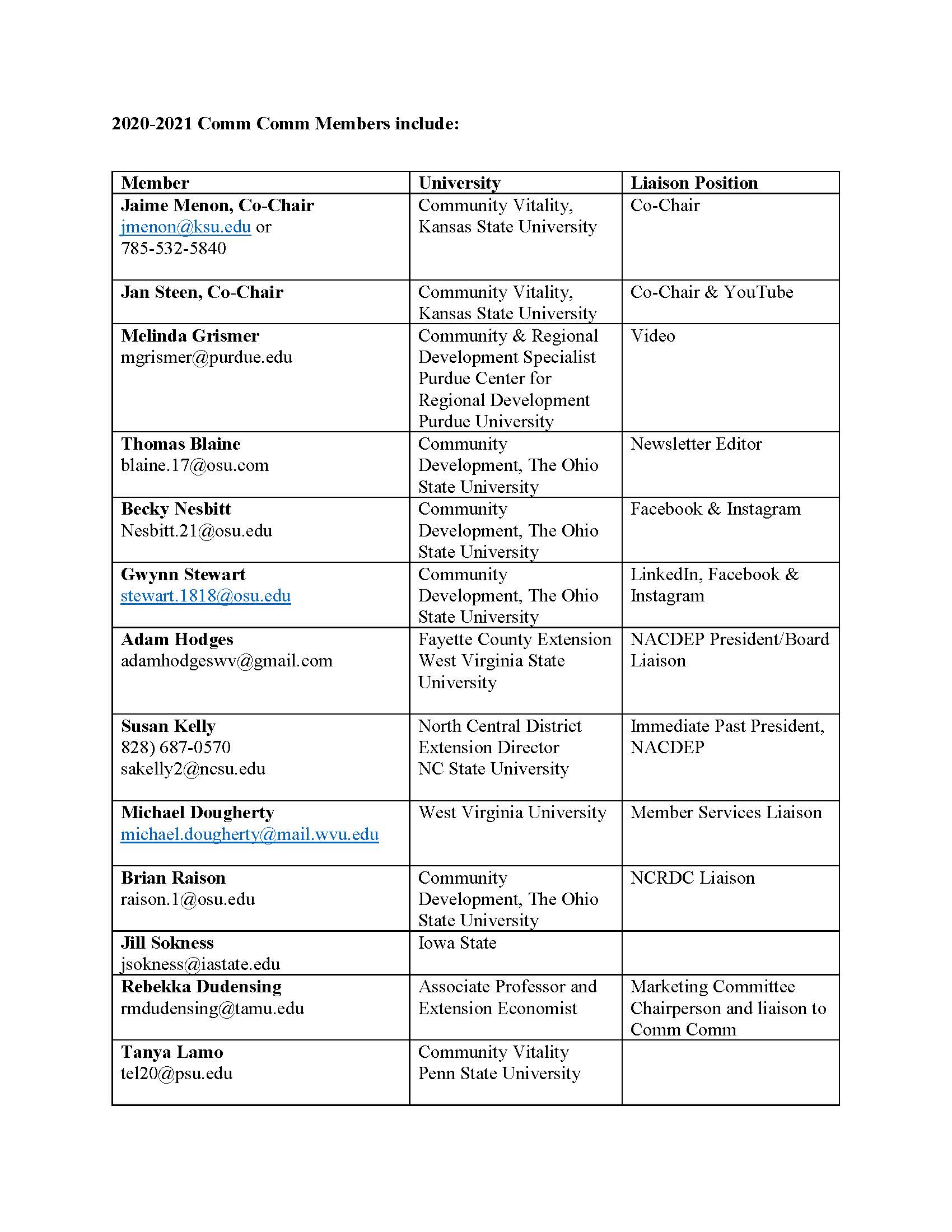
Extension Engaging GNAR(ly) Problems
Submitted by Jake Powell
Extension Specialist - Landscape Architecture and Environmental Planning
Utah State University
Gateway communities throughout the Intermountain West are facing a number of unprecedented challenges related to the COVID-19 pandemic. Gateway communities and the landscapes that surround them are regional, national, and international destinations with economies are often fueled by visitors. Efforts to contain the COVID-19 pandemic, such as closing national parks and restricting travel have disproportionality affected gateway communities. These communities are struggling to balance their tourismbased economies with the potential public health threats that come with welcoming back visitors.
In the first several weeks after the virus reached the intermountain region amenity-rich, gateway communities were some of the initial hot spots for the COVID-19 pandemic and first to implement strategies to mitigate its impact and spread. However, potential carriers of the COVID-19 virus continued to arrive from international and domestic destinations until travel restrictions were put in place. Furthermore, a wave of second homeowners looking to escape other impacted areas further threatened these local communities. These rural communities generally lack the appropriate medical supplies, staff, and support resources to test for and treat a large-scale infectious disease.
In addition, these communities often lacked information, data, staffing, and planning mechanisms needed to proactively respond at a community scale to the rapidly developing human health and economic crisis immediately occurring in their community.
The unique nature of the economic, health, and governance situations faced by gateway communities provided Utah State University Extension's new Gateway and Natural Amenity Region (GNAR) Initiative increased relevance and focus.
The Gateway Natural Amenity Region (GNAR) Initiative is an interdisciplinary team of university Extension staff and researchers, planners, state and federal organization staff, and NGO's dedicated to addressing the challenges specific to gateway communities. The GNAR Initiative team conducts research, educates, and builds the capacity of community planners and natural resource managers in gateway regions throughout Utah and the Intermountain West. The GNAR Initiative is housed within USU Extension's Institute of Outdoor Recreation and Tourism at Utah State University, the western United States most active outdoor recreation research program.
The effects of the COVID-19 pandemic on gateway communities spurred the GNAR Initiative to develop a series of responses focused on bringing communities together to listen to, better understand and then address challenges and share opportunities. The GNAR Initiative created a peer-to-peer information and resource sharing network to identify and address the unique challenges being faced by gateway communities throughout Utah and the Intermountain West.
The 'GNAR Community Response Network' provides a forum where elected officials, city and county planners, economic development specialists, local tourism department staff, land management agency staff, and non-profit organizations unite, share ideas, and identify immediate/high-priority needs and resources. The goal is to help them make more informed decisions as they respond to the spread of COVID-19 and mitigate its impact on the well-being of their residents and their local economies.
The GNAR Network workshops are a combination of both an open-forum, where Network participants can share their experiences, and facilitated discussions focused on specific (immediate/high-priority needs). The virtual workshops are recorded and made publicly available on the GNAR Initiative website (www.gnar.usu.edu). Key discussion points, resources, and relevant research and responses discussed during the workshops will also be shared on the website.
The COVID-19 pandemic has exposed the vulnerabilities of many western gateway communities. While the GNAR Initiative is working to focus on the pressing needs of the COVID-19 crisis in gateway communities the larger intent of the initiative remains, to gather, develop and share research, collaboration, and communication resources that builds more resilient GNAR communities now and into the future.
Beginner's Guide to Grant Writing: Train the Trainer
Submitted by Kris Parker
Adopt Purdue Extension's award-winning Beginner's Guide to Grant Writing workshop for your state! Participants will be able to host and co-teach the two-day workshop. Beginner's Guide to Grant Writing workshop is an efficient, economical, evidence-based option to help communities leverage financial resources that improve their quality of life.
Who: Extension staff and faculty interested in teaching Beginner's Guide to Grant Writing and/or coordinating a program in their state. We strongly recommend registering a team of two or more for the Train-the-Trainer.
When: August 27 (1:00 pm-4:00 pm CDT) and August 28 (10:00 am-1:00 pm CDT)
Where: This is a virtual workshop. A link to the webinar will be sent with the training materials.
Cost: $345 registration fee includes trainer kit, trainer manual, participant workbook, instruction, and ongoing support.
Registration: https://bit.ly/BGGWTtT2020
Questions: Contact Kris Parker at [email protected]u or 219-386-5232
Idaho is Excited to Host NACDEP in 2021
Submitted by Katie Hoffman-McFarland
As an Idaho native, I am excited to share the gem state with you! Although Idaho is not usually on anyone's "bucket list" for must-see destinations, we are truly a hidden gem in the west. Our team, made up of members from many western states, are excited to share with you what we have to offer in the west. Although community development in the west may be small and look different, we have many similarities to our colleagues across the nation. Our open landscapes and rural populations bring both challenges and opportunities. In fact, this year's conference theme "Open Spaces, Endless Possibilities" was inspired by our western uniqueness.
We hope to offer an abundance of possibilities to grow your community development skills and an open space to network and share ideas. We have great mobile workshops that will highlight the beauty and natural resources our area has to offer as well as giving participants a glimpse into small business, community art, commerce, and natural resource community development. The west will welcome the NACDEP 2021 Conference May 15- 19, , 2021, to the beautiful Coeur d'Alene Resort in Coeur d'Alene, Idaho, on the lake of the same name. It is pronounced kore-duh-LANE (I know you were dying to know!).
The lake and city were named after a native tribe who lived in the area and called themselves the Schitsu'umsh. They got the name Coeur d'Alene, which means "heart of an awl," from French-Canadian fur traders. Co-hosted by Washington and Idaho, the 2021 Conference will take place at the resort on Lake Coeur d'Alene. Although it may take some time getting the spelling right on your travel paperwork it will be worth it. We locals like to abbreviate it to CDA if that helps. It's an easy flight into Spokane, Washington and the resort offers shuttle service into Coeur d' Alene. Mark your calendars and we hope to see you in the west!
NIFA NACDEP News
Submitted by Brent Elrod
Six months into 2020 and who among us could've predicted the year thus far. Well, there were warning signs....
Many of us lucky enough to remain gainfully employed have been working remotely since mid-March due to a global pandemic. Memorial Day brought with it the horrifying video footage of George Floyd's killing by a police officer's knee pressed against his neck while other law enforcement stood passively by. The ensuing protests have brought into stark relief the scars of a much deeper divide - one that has its' roots in slavery and the resulting systemic racism.
In the midst of it all, you, your Board of Directors, and your conference organizers quickly pivoted to a virtual conference. Folks banded together and did what needed to get done to make the most of a difficult situation. Not unlike the people and communities you empower through your research and educational programming.
As they - and we - chart a course through these uncertain times, returning to the roots of "what works" will help these communities stabilize and rebound. Leadership development, community capacity building, health and economic development are cornerstones of vibrant communities. Innovation and entrepreneurship hasten growth and greater opportunity. Your individual and collective inputs into the process are the engines catalyzing that positive change - one person and one community at a time.
Because it can get lonely out there at times, being an active member of your professional association is a surefire way to charge one's batteries and spark new thinking. Committees don't volunteer themselves! This year has reminded us that we truly are in it together. Sharing resolve and building on one another's strengths helps end nightmares and realize dreams. Keep making dreams come true. For yourself. And those you serve.
A Letter To NACDEP Members
Submitted by Jennifer Russell
Dear NACDEP members,
At the start of the pandemic, community development professionals around the country were working hard to mitigate the impact of COVID-19 on businesses and families in their communities. In my territory among the Lower IL River Valley region of rural Illinois, restaurants play a vital role both economically and socially within these towns as the last surviving strong hold that handles the day-to-day food needs of local residents and workers and tourism spots along the trail. While a number of restaurants were able to utilize curbside pick-up by modifying their operations, University of Illinois Extension knew how critical information and additional training would be for these businesses not only in my region but also across the state. On April 22, 2020, I posted the blog article "Be ready when your doors reopen," in the University of Illinois Extension Creating Entrepreneurial Communities Blog.
Blog Article:
During the past several weeks, families and businesses around the country have endured tragic loss of human life, modified their way of life, and lost vital economic resources. Many of us stay at home "doing our part" not to risk exposure and illness that might further burden our hospitals, as others work to save lives and provide needed food and products.
As business owners plan for reopening, successful businesses will consider ways to bring customers back through their doors. Consider the range of customers: those with immune deficiencies who might be afraid to leave home, those who think there is no danger in getting out, and those who choose to clean extensively, wear masks, and check their temperature regularly. Each may need a unique message to regain their business.
How have you kept in contact with customers?
Have you called or emailed your customers?
Have you provided them a way to connect with you and encouraged that contact?
Have you started new policies to open up your business?
Are your policies clearly detailed so all customers feel safe and welcomed?
Many customers are looking for businesses who not only have extensive cleaning protocols, but have minimized potential health hazards, such as contact with products, exchange of currency, and entry points in and out of the store. Customers value stores where staff are adequately trained and clearly communicate how customers will be safe.
Your business has to outperform the expectations of all your customers. As you think about resuming operations, ask your customers:
Are there products and services our business could help you with during this time?
What is the best method to get those products and services to you?
What actions should we take to exceed your expectations while shopping at our store?
Your business may only get one chance to make a first impression with customers.
After submitting the blog article, it was important to identify additional resources to open safely while stressing strong customer service skills for these restaurants. I reached out to Community and Economic Development Extension colleagues followed by professors on campus in the FSHN, Hospitality Management Program and the Illinois Restaurant Association. After a few weeks of developing pertinent topics, speakers and marketing the program, over 550 restaurants/participants attended the webinars with both social media and numerous news outlets running the story across the state.
Based on our experiences in other programming, we know that many more participants view the program recordings at their own convenience. The archived presentations of both the May 28, 2020, Scaling Up Restaurant Operations: Financial Considerations and the June 4, 2020, Scaling Up Restaurant Operations: Safety Considerations webinars allow participants to access the original presentation along with resource materials on menu analysis and recipe costing (provided by faculty) which are of critical importance to restaurant businesses long-term survival.
We are currently in conversations for follow-up programming, as the collaboration proved valuable for all involved.
Source:
Jennifer Russell is a University of Illinois Extension educator in Community and Economic Development, serving communities in west central Illinois. Russell is a graduate of both University of Illinois and Southern Illinois University at Edwardsville. Russell is a member of the Community Development Society (CDS), the National Association of Community Development Extension Professionals (NACDEP) and Vice Chair of the Illinois chapter of (IL-ACDEP). With over 20 years of experience, Russell works with businesses, non-profits, and government and focuses her efforts on customer service training, strategic planning, tourism development and building strong collaborations to address issues within the region.
Show Us the Awesome!
Submitted by Jaime Menon, and Jan Steen Comm Comm Co-chairs
Hello All! NACDEP Comm Comm Co-Chairs Jaime Menon and Jan Steen of Kansas State Research and Extension here for an ask (don't worry, it isn't painful!).
Many of you may have attended NACDEP 2020 (such a great virtual conference!), and during the post conference discussion/organization the NACDEP Communications Committee we noted there aren't a lot of good publicity photos for NACDEP. At the moment we have very few to utilize for social media, print, etc. That's where we need you! If you are like me, you have plenty of awesome photos on your phone or camera that need to be seen! These can be community projects, photos at workshops, out in the field, anything that says "this is our awesome work!".
We have included a few examples here for you to draw ideas from.
If you can, or can delegate, we would appreciate very much if you could populate the following link with photos (as soon as you can please). Please create a folder with the name of your state, and any photo releases you may need to accompany (if applicable) with them:
CLICK HERE to add your State's Photos!
We hope to build a repository of photos for future use for NACDEP publications/social media/newsletter, etc.
Thank you for all you do! - Jaime Menon and Jan Steen, Co-Chairs of NACDEP Comm Comm
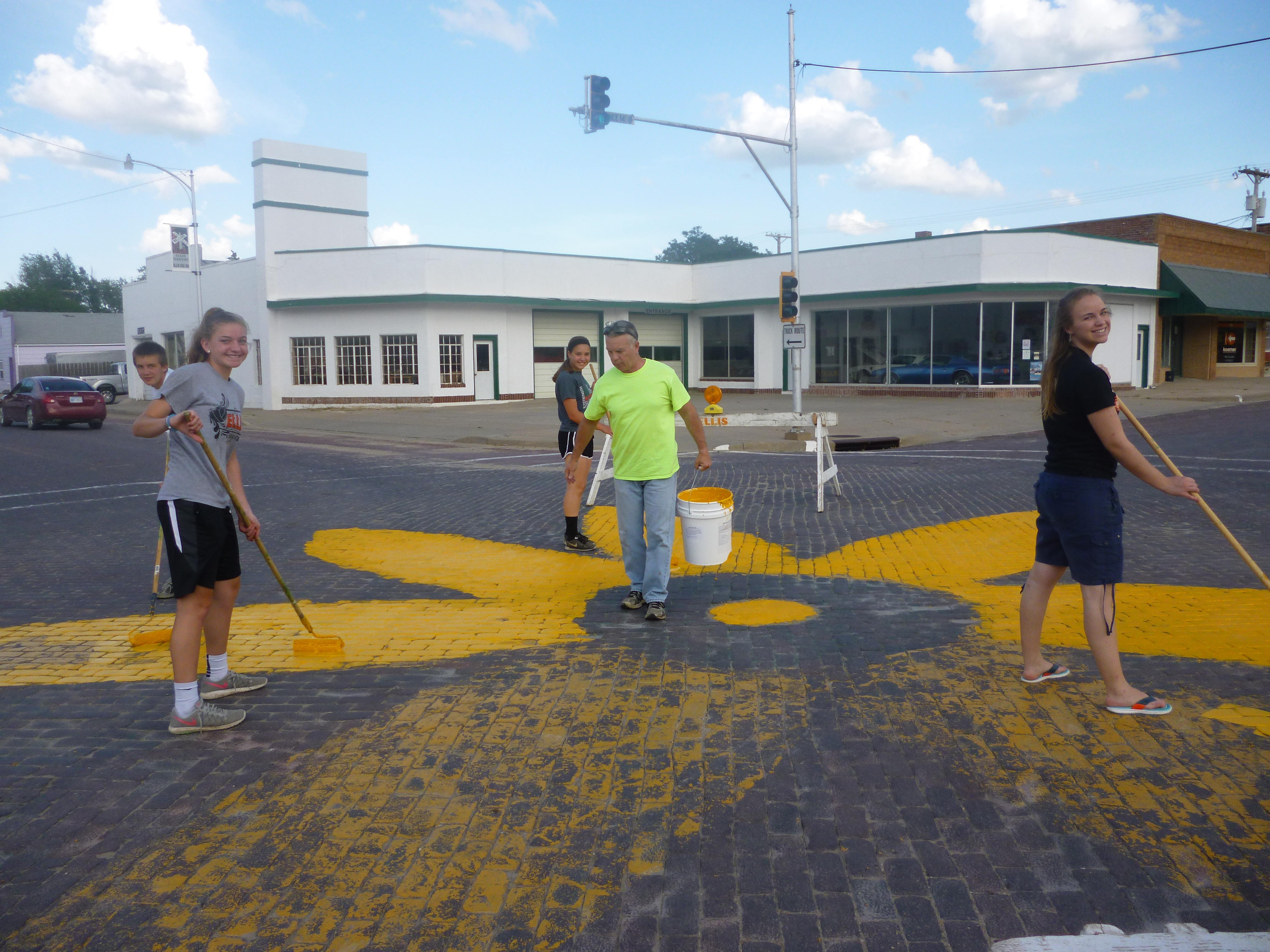 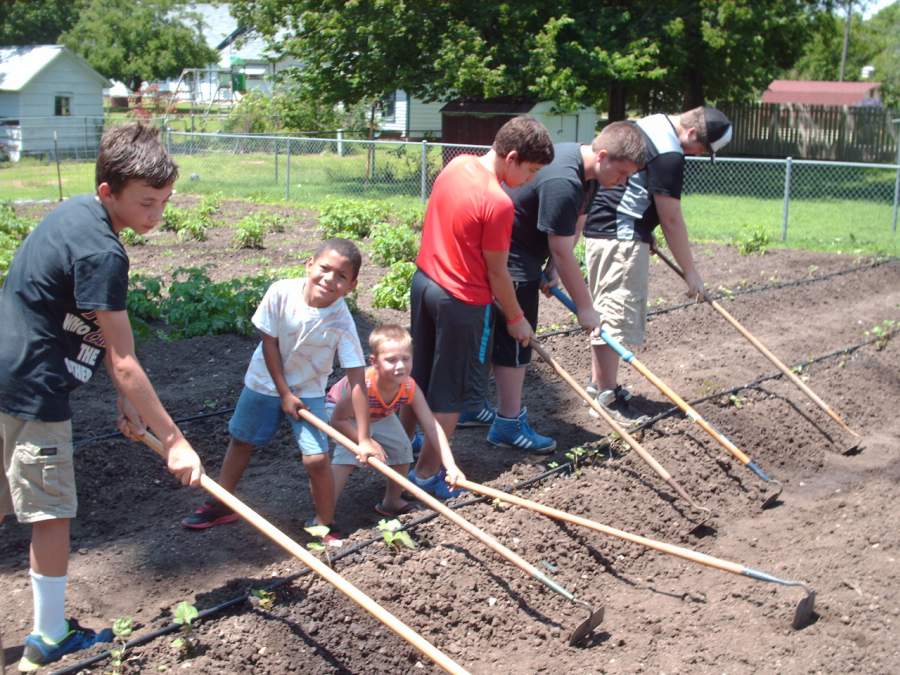
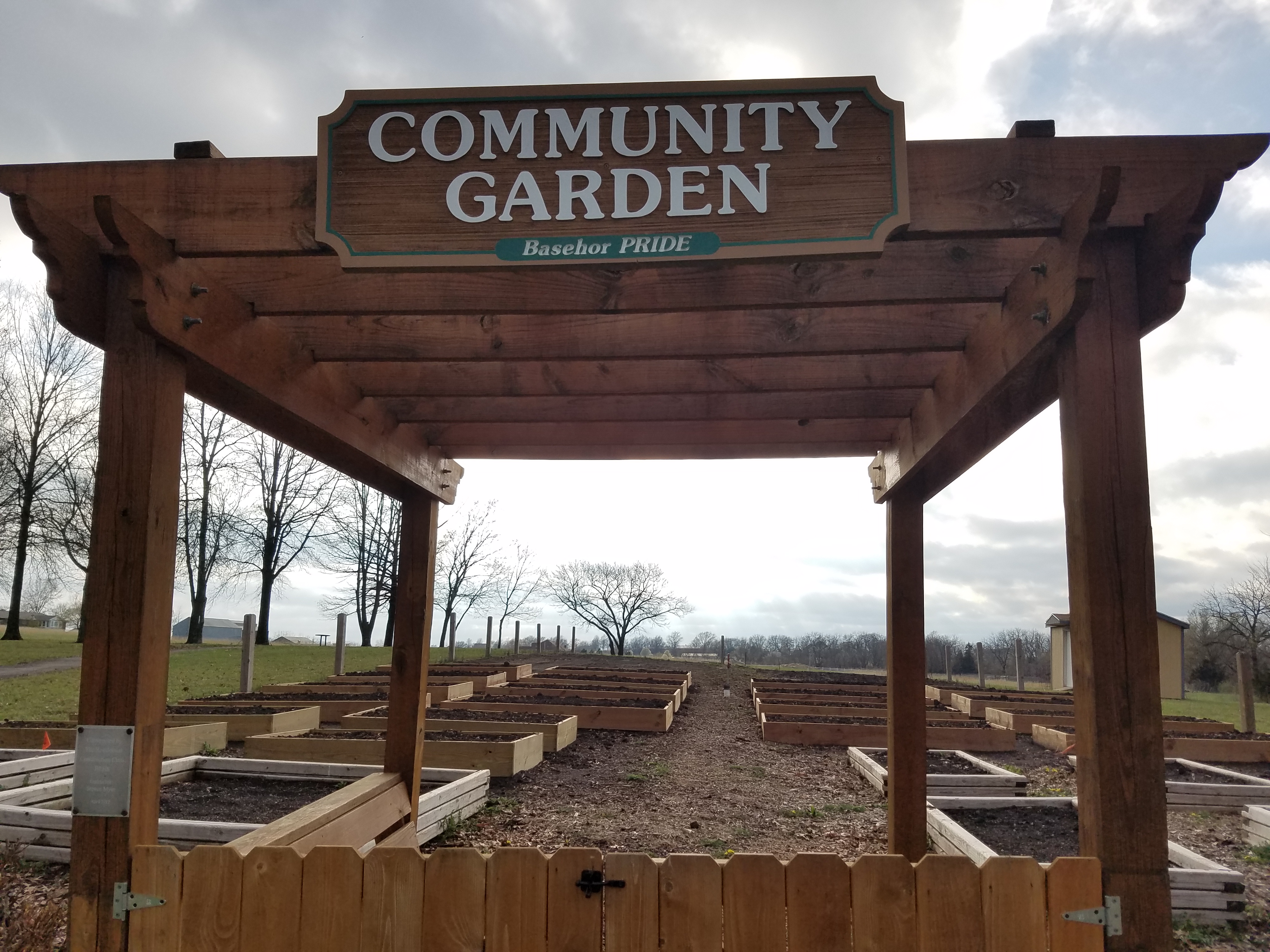 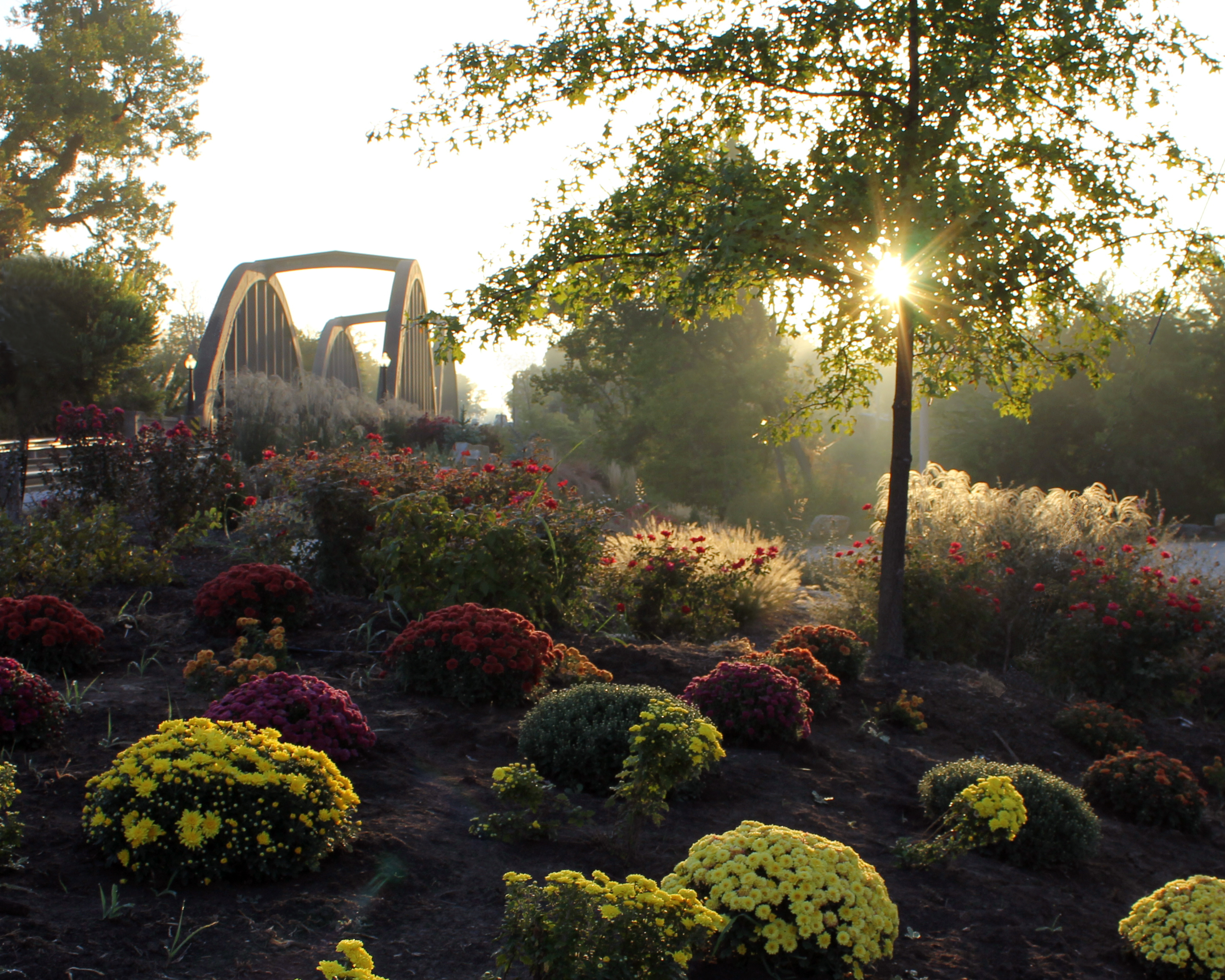
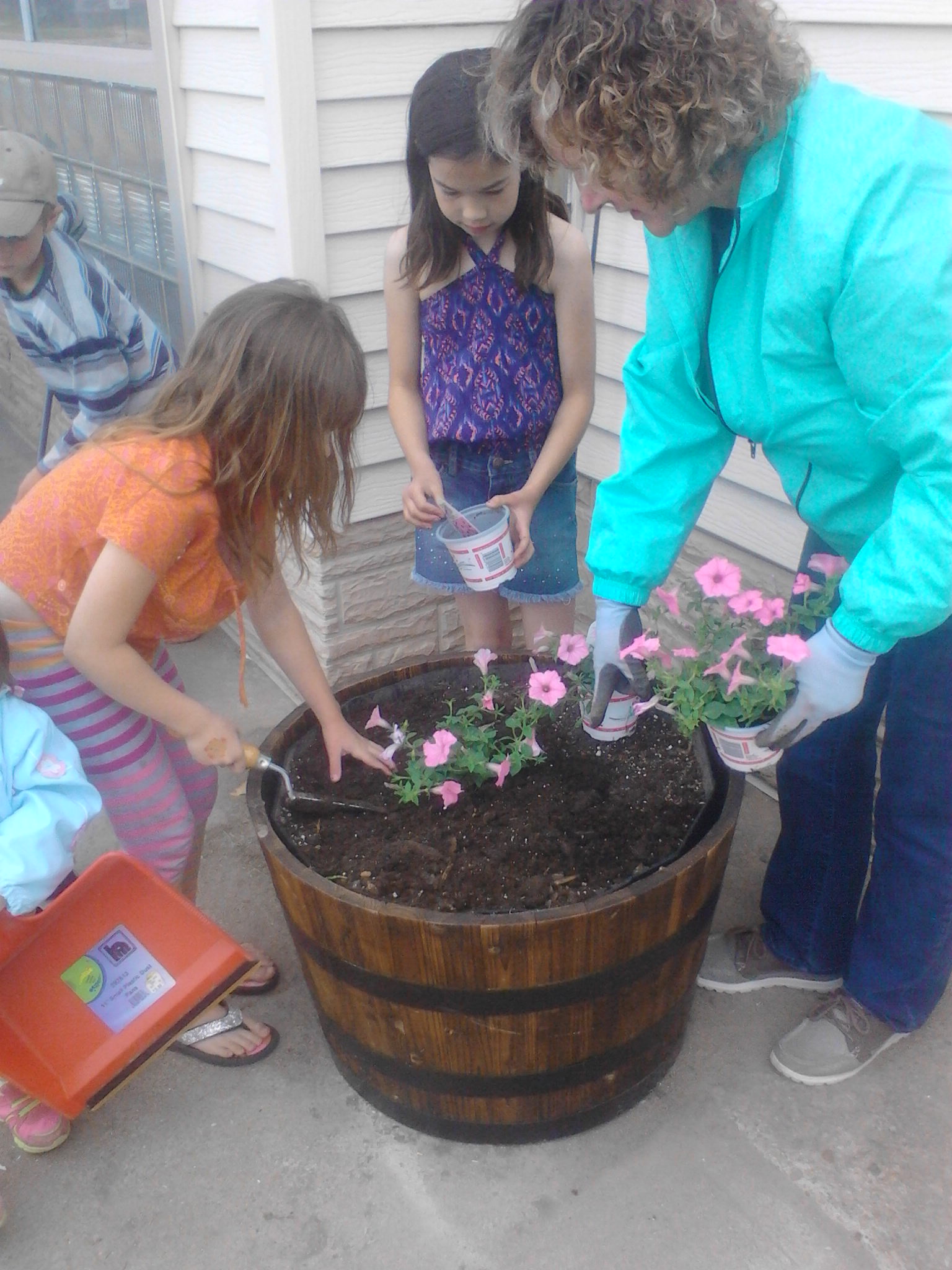 .jpg)
|